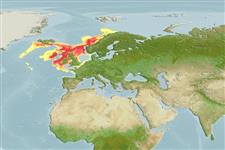Elasmobranchii (tubarões e raias) (sharks and rays) >
Rajiformes (Skates and rays) >
Rajidae (Skates)
Etymology: Dipturus: Greek, di = two + Greek, pteryx = fin (Ref. 45335).
Environment: milieu / climate zone / depth range / distribution range
Ecologia
marinhas demersal; intervalo de profundidade 1 - 1500 m (Ref. 114953), usually ? - 200 m (Ref. 114953). Temperate; 49°N - 70°N, 32°W - 15°E (Ref. 114953)
Northeast Atlantic: Iceland to the British isles, it was formerly more widespread, including the Mediterranean Sea and North Africa, but its range is thought to be reduced due to fishing.
Tamanho / Peso / Idade
Maturity: Lm ? range ? - ? cm
Max length : 285 cm TL macho/indeterminado; (Ref. 114424); peso máx. publicado: 113.0 kg (Ref. 114424)
Descrição suscinta
Chaves de identificação | Morfologia | Morfometria
Espinhos anais: 0. This species is characterized by the following: snout long and pointed, length 3.7-5.1 times orbit length; disc broadly rhombic, anterior margin deeply concave; a row of 12-18 predorsal thorns in median row along tail (disc smooth in young); lateral thorns on tail pointed towards head; interspace between dorsal fins (2.4 ± 0.5 TL); upper surface dark olive-green in young with small pale spots, becoming greyish-brown; underside greyish or whitish; iris olive green (Ref. 114953, 127223).
A benthic species found in shelf and slope waters, mainly within the 200 m range but occasionally down to 1,500 m (Ref. 114953, 127218, 127220, 127222). Feeds on all kinds of bottom invertebrates and fish, including other skates (Ref. 114953). Oviparous, with long embryonic development. Males reach maturity at ca. 185 cm TL, females at 197 cm TL; birth size at ca. 29 cm TL, from large egg cases (up to 25 cm) (Ref. 114953). Biology unclear due to past taxonomic confusion.
Ciclo de vida ou comportamento de acasalamento
Maturities | Reprodução | Spawnings | Egg(s) | Fecundities | Larvas
Last, P.R., S. Weigmann and L. Yang, 2016. Changes to the nomenclature of the skates (Chondrichthyes: Rajiformes). In: Last and Yearsley (eds.). Rays of the World: Supplementary Information. CSIRO Special Publication. 11-34. (Ref. 118749)
Status na Lista Vermelha da UICN (Ref. 130435)
Ameaça para os humanos
Harmless
Uso pelos humanos
Ferramentas
Relatórios especiais
Baixar XML
Fontes da internet
Estimates based on models
Índice de diversidade filogenética (Ref.
82804): PD
50 = 0.5000 [Uniqueness, from 0.5 = low to 2.0 = high].
Bayesian length-weight: a=0.00282 (0.00133 - 0.00596), b=3.25 (3.08 - 3.42), in cm total length, based on LWR estimates for this Genus-body shape (Ref.
93245).
Nível Trófico (Ref.
69278): 4.1 ±0.6 se; based on size and trophs of closest relatives
Resiliência (Ref.
120179): Muito baixo(a), tempo mínimo de duplicação da população maior que 14 anos (Preliminary K or Fecundity.).
Fishing Vulnerability (Ref.
59153): Very high vulnerability (90 of 100).
